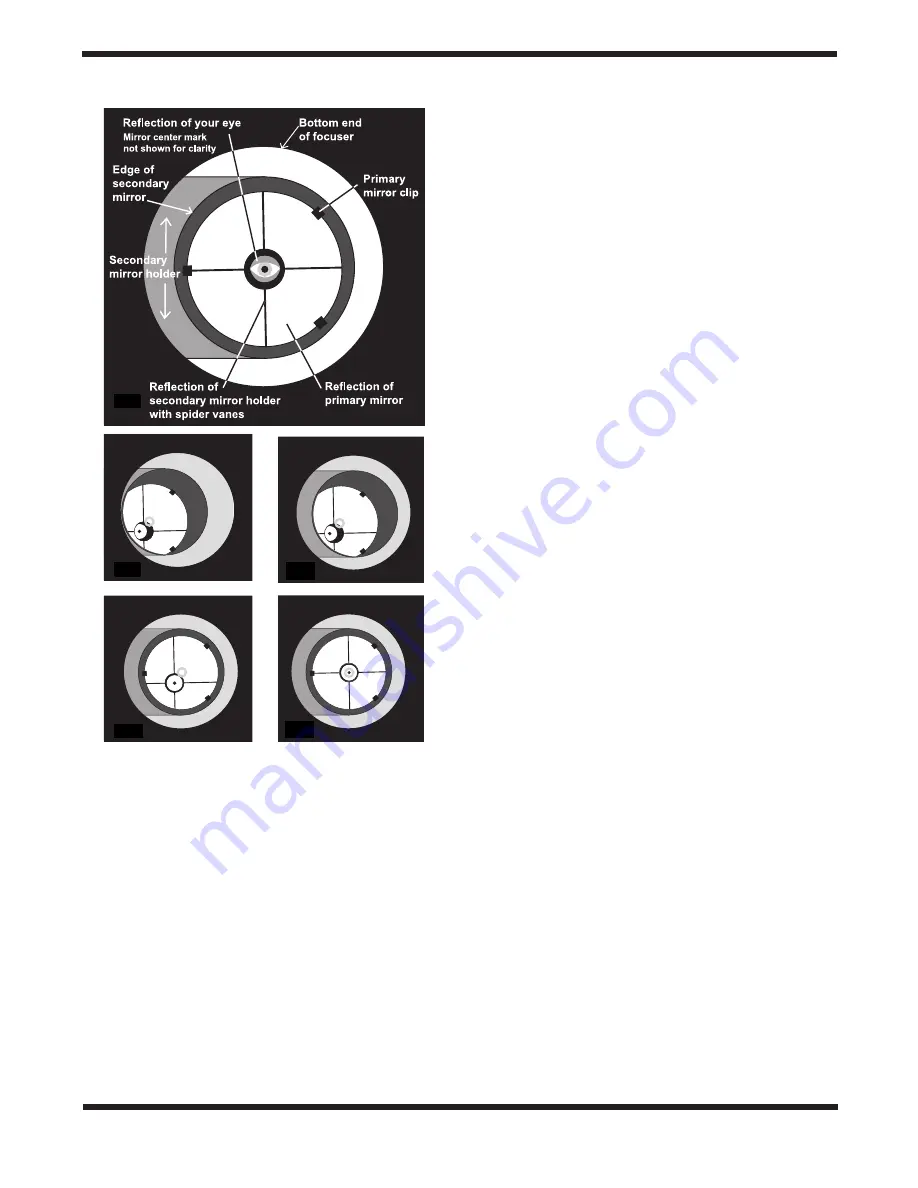
12
The Collimation Cap and Mirror Center Mark
Your SkyView Pro 6 EQ comes with a collimation cap. This is
a simple cap that fits on the focuser drawtube like a dust cap,
but has a hole in the center and a silver bottom. This helps
center your eye so that collimation is easy to perform. Figures
13b through 13e assume you have the collimation cap in
place.
In addition to the collimation cap, the primary mirror is marked
with a circle at its exact center. This “center mark” allows you
to achieve a precise collimation of the primary mirror; you
don’t have to guess where the center of the mirror is. You sim-
ply adjust the mirror position (described below) until the reflec-
tion of the hole in the collimation cap is centered in the ring.
The center mark is also required for best results when using
other collimating devices, such as Orion’s LaserMate Laser
Collimator, obviating the need to remove the primary mirror
and mark it yourself.
Note: The center ring sticker need not ever be removed
from the primary mirror. Because it lies directly in the
shadow of the secondary mirror, its presence in no way
adversely affects the optical performance of the tele-
scope or the image quality. That might seem counterintu-
itive, but its true!
Aligning the Secondary Mirror
With the collimation cap in place, look through the hole in the
cap at the secondary (diagonal) mirror. Ignore the reflections
for the time being. The secondary mirror itself should be cen-
tered in the focuser drawtube, in the direction parallel to the
length of the telescope. If it isn’t, as in Figure 13b, it must be
adjusted. This adjustment will rarely, if ever need to be done.
It helps to adjust the secondary mirror in a brightly lit room
with the telescope pointed towards a bright surface, such as
white paper or wall. Also placing a piece of white paper in the
telescope tube opposite the focuser (in other words, on the
other side of the secondary mirror) will also be helpful in colli-
mating the secondary mirror. Using a 2mm Allen wrench,
loosen the three small alignment set screws in the center hub
of the 4-vaned spider several turns. Now keep the mirror’s
holder stationary (be careful not to touch the surface of the
mirrors), while turning the center screw with a Phillips head
screwdriver (See Figure 14). Turning the screw clockwise will
move the secondary mirror toward the front opening of the
optical tube, while turning the screw counter-clockwise will
move the secondary mirror toward the primary mirror.
Note: When making these adjustments, be careful not to
stress the spider vanes or they may bend.
When the secondary mirror is centered in the focuser draw-
tube, rotate the secondary mirror holder until the reflection of
the primary mirror is as centered in the secondary mirror as
possible. It may not be perfectly centered, but that is OK. Now
tighten the three small alignment screws equally to secure the
secondary mirror in that position.
If the entire primary mirror reflection is not visible in the sec-
ondary mirror, as in Figure 13c; you will need to adjust the tilt
of the secondary mirror. This is done by alternately loosening
one of the three alignment set screws while tightening the
other two, as depicted in Figure 15. The goal is to center the
primary mirror reflection in the secondary mirror, as in Figure
13d. Don’t worry that the reflection of the secondary mirror
(the smallest circle, with the collimation cap “dot” in the cen-
ter) is off-center. You will fix that in the next step.
Figure 13.
Collimating the optics. (a) When the mirrors are
properly aligned, the view down the focuser drawtube should look like
this (b) With the collimation cap in place, if the optics are out of
alignment, the view might look something like this. (c) Here, the
secondary mirror is centered under the focuser, but it needs to be
adjusted (tilted) so that the entire primary mirror is visible. (d) The
secondary mirror is correctly aligned, but the primary mirror still needs
adjustment. When the primary mirror is correctly aligned, the “dot” will
be centered, as in (e).
a.
b.
c.
d.
e.






























